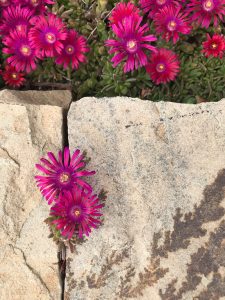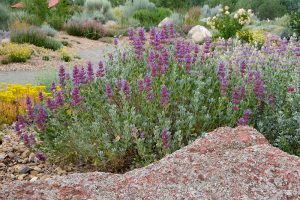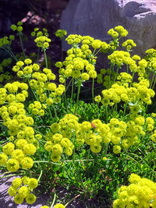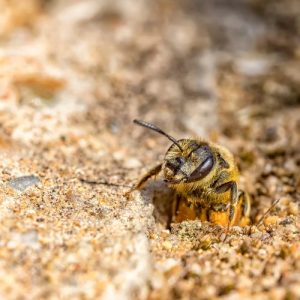Spring Garden Cleanup in a Waterwise Garden: Questions and Answers!
In this video, Horticulturist Grace Johnson of Denver Botanic Gardens Chatfield Farms demonstrates how she approaches spring garden cleanup in the Plant Select Demonstration Garden.
If you have questions about Grace’s cleanup techniques, timing and mulch choices, scroll on for her Q&A.
Spring cleanup techniques
In your video, you use a rake to clean out leaf debris. Are you raking over the plants? Or, are you raking around the plants?
GRACE JOHNSON: It depends on the plant.
Some plants—such as Pterocephalus depressus (Moroccan pincushion flower)—can handle being raked over.
Other plants are quite delicate, like Delosperma (ice plant), Sedum sediforme (Turquoise Tails blue sedum) and Petrosedum rupestre ‘Rice Creek’ (WINTER FIRE® Sedum).
You can accidentally break off pieces and cause damage to these plants if you rake across them harshly.
If you have more delicate plants (like the Delosperma pictured at right), it’s often best to use your hands or a leaf blower to remove debris. Save the rake for your pathways and unplanted areas.
Which plants are hedge trimmers and shears best for? Are there any plants you wouldn’t use them on?
GRACE JOHNSON: I like to use the hedge trimmers on thick stemmed perennials and warm season ornamental grasses.
I wouldn’t use them on extremely delicate or small plants. The hedge trimmer would potentially cause damage. Plus, small and delicate stems can be hard to see when you’re bending over with a power tool. To perform more detailed cutbacks on fragile plants, I use hand pruners while kneeling.
How far do you cut back ornamental grasses and perennials? Do you cut the stems all the way to the ground?
GRACE JOHNSON: It depends on the plants you have in your garden.
The height you cut your grasses will depend on the species of grass. In general, it’s best not to cut grasses all the way to the ground. But you don’t want to cut them too high either because the sun can’t penetrate the crown, which can slow the new growth process.
For perennials, a lot of them will sprout new stems from the base of the plant. Typically, cutting old stems won’t interfere with their new growth. So, for the sake of cleanliness, I do tend to cut many perennial stems as low to the ground as possible. As far as I know, this doesn’t cause damage to the plants that I work with. Most of them push out fresh stems each spring. Leaving stems and stumps throughout the garden for the summer can be unsightly and distracting. It’s best to have things clear to see new, green growth sprouting.
With that said, there are certain perennials that bud on old stems. For example, Salvia pachyphyllia (Mojave sage) develops woody stems. In the spring, you may want to remove damaged or unattractive stems, but it’s best to not prune back into the woody stems.
If you’re unsure of how a plant blooms, you can keep an eye on it to see if new stems emerge from the ground or if it only will branch out from old stems. This can give you a hint on whether this plant should be cut to the ground or not.
Also, do your research! We’re lucky to have a lot of knowledge available online at our fingertips, and the Plant Select online plant descriptions have good tips on how to maintain the plants.
What about plants that have more evergreen foliage?
GRACE JOHNSON: I don’t cut back plants with evergreen foliage.
For example, Eriogonum umbellatum var. aureum (KANNAH CREEK® buckwheat) has a beautiful fall and winter color. Once temperatures warm back up, these leaves will again turn green, and more leaves will appear.
The only part of Eriogonum that I cut back are the spent seedheads after flowering.
Garden cleanup timing
Why do you wait until spring to cut back most grasses and perennials?
GRACE JOHNSON: There are many reasons to delay the cutback of grasses and plants until springtime.
First, most ornamental grasses and many Plant Select perennials have ‘winter interest.’ Winter interest is when a plant provides beauty and function in a garden space, even when it’s dormant. This could be a pleasing texture, color, or even the sounds and sights of the plant fluttering in the wind. Depending on the plant, it can be very pleasing to the eye, even in the winter. Winter gardens don’t have to look barren!
Another reason to leave your grasses and perennials standing through the colder months is to provide insulation to the crown of the plant. When you cut plants back in the fall, you run the risk of cutting too deeply into the crown. This can expose the plant to moisture and cold temperatures that can cause dieback and rot.
And finally, it’s helpful to leave plants standing through the winter for the benefit of pollinators and beneficial insects. For example, a lot of pollinators and other insects will use ornamental grasses as a shelter from the winter cold and snow. Some use loose grass fibers or hollow perennial stems as nesting material.
Providing shelter, space and habitat for these creatures can help your garden thrive long term.
What’s the ideal time to cut back grasses and perennials in the spring?
GRACE JOHNSON: Typically, perennials and grasses can be cut around the same time: late spring. This timing benefits pollinators and beneficial insects. Raking up garden leaves and cutting back perennials and grasses too early can expose these creatures to snow and cold temperatures, which may kill them.
As a guideline, some suggest waiting until after your winter gear is put away. That way, there’s no risk of hard frosts, snow, and bitter temperatures harming pollinators and beneficial insects.
However, this timing may not be possible for everyone, including some landscape professionals and public gardens. This includes me. As a horticulturist covering a lot of acreage on my own, I have to cut back plants earlier. By mid-April, I’m diving headfirst into planting thousands of perennials, so I have to cut my gardens back sooner.
If you’d like to learn more the relationship between spring garden cleanup and pollinators, Entomologist Lisa Mason of the Colorado State University Extension has a helpful article explaining when and how different bees emerge from hibernation and pollinator considerations for timing of spring garden cleanup.
Pea gravel or wood mulch
Why are you using pea gravel mulch in your Plant Select Demonstration Garden rather than wood mulch?
GRACE JOHNSON: I have many opinions regarding the use of pea gravel over wood mulch. Pea gravel is my preference for many reasons.
First, I feel that pea gravel is more indicative of a western garden, as opposed to wood mulch. For example, states like Colorado aren’t known for having a lot of trees, except in their mountainous areas. Native plants, especially plains and foothills species, evolved here without a lot of organic debris surrounding them. Organic debris can sometimes trap moisture and contribute to rot.
In addition, I feel that pea gravel provides better water infiltration, as well as good drainage. Sometimes, older wood mulch that has been baking in the sun can solidify and cause almost mat-like conditions, leading to water runoff instead of infiltration.
It may sound contradictory that wood mulch can cause rot AND take water away, but both have happened in gardens here at Denver Botanic Gardens Chatfield Farms. I think it may have to do with the age of the wood mulch and its placement. Wood mulch that is older and in full sun can lead to water runoff. Fresh wood mulch in shady conditions can lead to rot and damp conditions.
Water infiltration is important for many of us in states like Colorado because we traditionally have heavy clay soils. Moreover, we are in the ROCKY Mountains! Why not use rock as our mulch and celebrate our sense of place?
There are research studies going on right now about the use of different mulches, including one at Denver Botanic Gardens Chatfield Farms. There should be more information about this topic within the next year or two.





